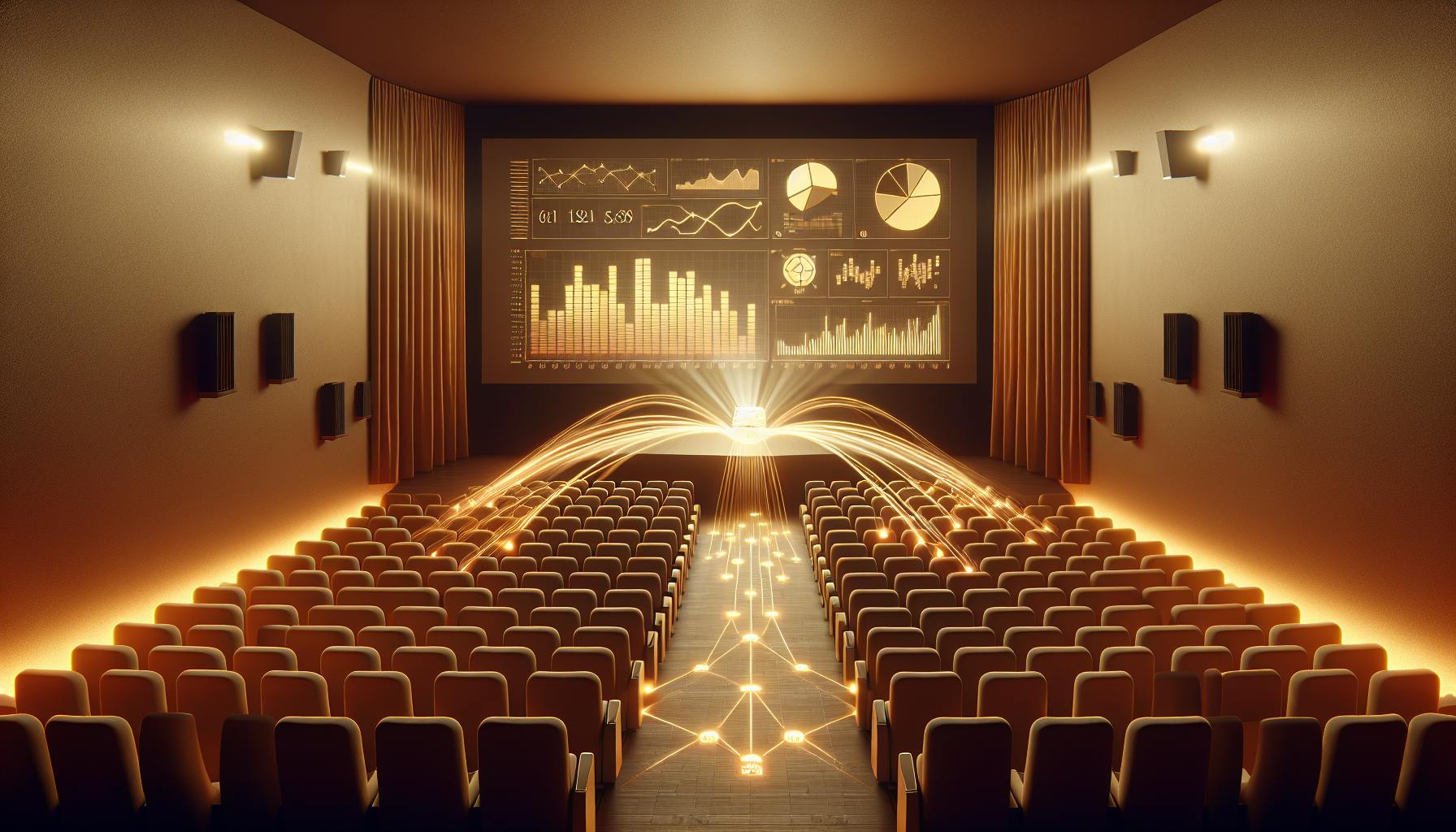Optimizing movie showtimes is crucial for cinemas to maximize attendance and revenue. This involves analyzing factors like demand, market trends, and audience preferences to make informed scheduling decisions.
Key Steps:
-
Gather Data
-
Centralize data sources: POS systems, online booking platforms, third-party analytics
-
Set up real-time analytics to monitor trends
-
-
Analyze Showtime Trends
-
Find peak showtimes for different movie types
-
Forecast demand using market data and tools like Google Trends
-
-
Create Optimized Schedule
-
Use algorithms to schedule based on forecasted demand
-
Adjust for special events, holidays, and regional availability
-
-
Implement and Refine
-
Use scheduling software to automate and test scenarios
-
Continuously refine strategy based on feedback and data analysis
-
-
Monitor and Adjust
-
Review key metrics like occupancy rates and revenue per screening
-
Use reporting tools for real-time performance data and competitor analysis
-
Gathering Cinema Data
To optimize showtimes, cinemas need to collect relevant data to make informed decisions. This initial phase is crucial in gathering data that will help create schedules that attract more visitors and increase revenue.
Centralizing Data Sources
Cinemas can gather data from various systems, including:
| Data Source | Description |
|---|---|
| Point of Sale (POS) systems | Sales data and customer information |
| Online booking platforms | Booking data and customer preferences |
| Third-party analytics services | Market trends and audience insights |
Setting Up Real-Time Analytics
Real-time analytics help cinemas monitor their performance and make timely decisions. With real-time dashboards and analytics platforms, cinemas can:
-
Track hourly and daily trends for admission rates and cinema traffic
-
Identify types of movies correlated to cinema traffic
-
Analyze peak showtimes and forecast with market data
By gathering and centralizing data, cinemas can create a solid foundation for showtime optimization. The next step is to analyze showtime trends to identify opportunities for improvement.
Analyzing Showtime Trends
Analyzing showtime trends is a crucial step in optimizing showtimes for cinemas. By examining historical data and market trends, cinemas can identify patterns and preferences in moviegoer behavior, ultimately leading to more informed scheduling decisions.
Finding Peak Showtimes
To determine the most popular showtimes, cinemas can analyze sales data from their point of sale (POS) systems, online booking platforms, and third-party analytics services. By centralizing these data sources, cinemas can identify peak showtimes and days for different types of movies.
| Data Source | Description |
|---|---|
| POS systems | Sales data and customer information |
| Online booking platforms | Booking data and customer preferences |
| Third-party analytics services | Market trends and audience insights |
For example, a cinema may find that:
-
Friday evenings are the busiest for blockbuster releases
-
Matinee shows on weekends are more popular for family-friendly films
Forecasting with Market Data
In addition to analyzing internal data, cinemas can utilize external tools like Google Trends to forecast demand and understand market dynamics. By examining search trends and online engagement, cinemas can anticipate which movies will be in high demand and schedule accordingly.
For instance, if a highly anticipated movie is releasing soon, a cinema may want to allocate more screens and showtimes to meet the expected demand.
By analyzing showtime trends and forecasting with market data, cinemas can create schedules that are more likely to attract larger audiences and increase revenue. The next step is to create a showtime schedule that takes into account these insights and optimizes showtimes for maximum attendance and revenue.
Creating a Showtime Schedule
Creating a showtime schedule is a crucial step in optimizing showtimes for cinemas. By translating data insights into a practical scheduling plan, cinemas can align their operational goals with customer demand.
Scheduling Based on Demand
To create an effective showtime schedule, cinemas can use an intelligent optimization algorithm that suggests optimal showtimes based on forecasted demand. This algorithm analyzes historical sales data, market trends, and external factors like weather and holidays to determine the most profitable showtimes.
| Factor | Description |
|---|---|
| Historical sales data | Analyze past sales to identify patterns and trends |
| Market trends | Examine current market conditions to anticipate demand |
| External factors | Consider weather, holidays, and other external factors that may impact demand |
Adjusting for Special Events
Cinemas must also adjust their film schedules to account for special events, holidays, and regional film availability. By doing so, they can maximize attendance and revenue during these periods.
| Event Type | Adjustment |
|---|---|
| Holidays | Schedule more family-friendly films and increase showtimes |
| Film festivals | Adjust schedules to accommodate festival schedules and demand |
| Premieres | Schedule additional showtimes to meet high demand |
By creating a showtime schedule that takes into account demand, special events, and operational goals, cinemas can optimize their showtimes and increase revenue.
sbb-itb-b1b0647
Implementing the Optimized Schedule
Now that you have created an optimized showtime schedule, it's time to put it into action. In this section, we'll explore the practical aspects of rolling out the new schedule, including training staff and marketing the changes to moviegoers.
Using Scheduling Software
To streamline the scheduling process, consider using software solutions like Cinema Intelligence. These tools can help automate the scheduling process, reducing manual errors and saving time.
Benefits of Scheduling Software:
| Benefit | Description |
|---|---|
| Automation | Reduce manual errors and save time |
| Scenario Testing | Test different showtime scenarios to determine the most profitable options |
| Data Analysis | Analyze sales data and market trends to inform scheduling decisions |
| Flexibility | Easily adjust the schedule to accommodate special events or changes in demand |
Refining the Strategy
Implementing an optimized showtime schedule is just the first step. To ensure long-term success, it's essential to collect feedback from moviegoers and staff to refine the scheduling strategy over time.
Ways to Refine the Strategy:
1. Conduct Regular Surveys: Gather feedback from moviegoers to understand their preferences and concerns.
2. Hold Staff Meetings: Discuss scheduling challenges and opportunities with staff to identify areas for improvement.
3. Analyze Sales Data and Market Trends: Identify patterns and trends to inform scheduling decisions.
4. Make Adjustments: Refine the schedule based on feedback and data analysis to ensure it remains effective.
Monitoring and Adjusting
Monitoring and adjusting your showtime schedule is crucial to ensure it remains effective in driving revenue and attendance. In this section, we'll explore the importance of continuously monitoring key performance indicators (KPIs) and adjusting strategies using real-time performance data.
Reviewing Key Metrics
To measure the success of your showtime optimization, define and regularly review KPIs such as:
| Metric | Description |
|---|---|
| Occupancy rates | Track the percentage of available seats sold for each showtime. |
| Revenue per screening | Monitor the average revenue generated per showtime. |
| Concession sales | Analyze the sales of food and beverages at each showtime. |
Regularly reviewing these metrics will help you identify areas of improvement and make informed decisions to refine your scheduling strategy.
Using Reporting Tools
Tools like Showtime Analytics provide visual market competitor analysis and circuit performance overviews, enabling you to make informed adjustments to your showtime schedule. With real-time performance data, you can:
-
Identify trends and patterns in attendance and revenue.
-
Compare your cinema's performance to competitors.
-
Analyze the impact of special events and holidays on attendance.
Conclusion
By now, you've learned how to optimize showtimes for cinemas using data. This guide has covered the essential steps to maximize attendance and revenue.
Recap
Optimizing showtimes is an ongoing process that requires continuous monitoring and refinement. By using real-time performance data, you can identify areas for improvement, make informed decisions, and stay ahead of the competition.
Key Takeaways
-
Use data to inform your scheduling strategy, rather than relying on intuition or guesswork.
-
Continuously monitor and refine your showtime schedule to ensure it remains effective.
-
Stay flexible and adapt to changes in market trends, consumer behavior, and technological advancements.
Final Thoughts
With the right approach to data-driven showtime optimization, you can unlock the full potential of your cinema and provide an exceptional experience for your customers. Remember to stay focused on using data to drive your decisions and continuously refine your strategy to stay ahead of the competition.
Resources
Here, you'll find a curated list of tools, platforms, and research materials to help you further explore cinema showtime optimization.
Data Integration Tools
These platforms offer seamless integration of cinema data for better analytics and decision-making.
| Tool | Description |
|---|---|
| Showtime Analytics | Connect to any data source, integrate everything together, and build visually rich analytics applications and solutions. |
| Comscore | A strategic partner of Showtime Analytics, providing market comparison and competitor analysis tools for cinema exhibitors. |
Research and Case Studies
Explore these resources for deeper insights into advanced optimization techniques and their real-world applications.
| Resource | Description |
|---|---|
| "Optimising Cinema Operations" by [Author's Name] | A study on how data analytics can help optimize cinema operations by analyzing and predicting traffic, optimizing staffing, and managing planning. |
| "Benchmark: The Market Comparison and Competitor Analysis Tool for Cinema Exhibitors" by Showtime Analytics | A case study on the introduction of Benchmark, a market comparison and competitor analysis tool for cinema exhibitors. |
These resources provide valuable insights and tools to help cinema owners and managers optimize their showtimes and improve their overall operations.
FAQs
How are movie times determined?
Movie showtimes are determined by considering several factors, including:
| Factor | Description |
|---|---|
| Financial performance | The movie's previous weekend performance |
| Type of film | The genre and target audience of the movie |
| Moviegoers' needs | The demand for showtimes and audience preferences |
| Studio agreements | The agreements between theaters and movie studios |
The goal is to maximize attendance and revenue while providing a variety of showtime options for guests.


